 Take A Deep Breath
Take A Deep Breath
… but don’t hold it while waiting for everything to turn out well.
Here we go again — yet another beginning of yet another year. Though one day’s much like the next, normally I find this symbolic fresh start buoying. This time around I can’t shake a lingering sense of dread.
Around these parts we hunker down and avoid all the trappings of the holidays, just poking our heads out when we know it’s over. If the season left you frazzled, and the impending presidential transfer of power has you anxious, take a moment to calm yourself down. Things are likely to get much, much worse very quickly, so you’ll need to have your wits about you.
•
You might start with “Solo, Piano — N.Y.C.,” a New York Times Op-Doc by Anthony Sherin published four years ago, on December 11, 2012. It’s a 5-minute film in stills about an old, abandoned upright piano meeting its fate on the sidewalks of new York after a January snowstorm, as seen from the window of Sherin’s Washington Heights apartment. Spoiler alert: Help, alas, does not arrive in the nick of time — so you can think of it as an elegiac metaphor for democracy as we have known it.
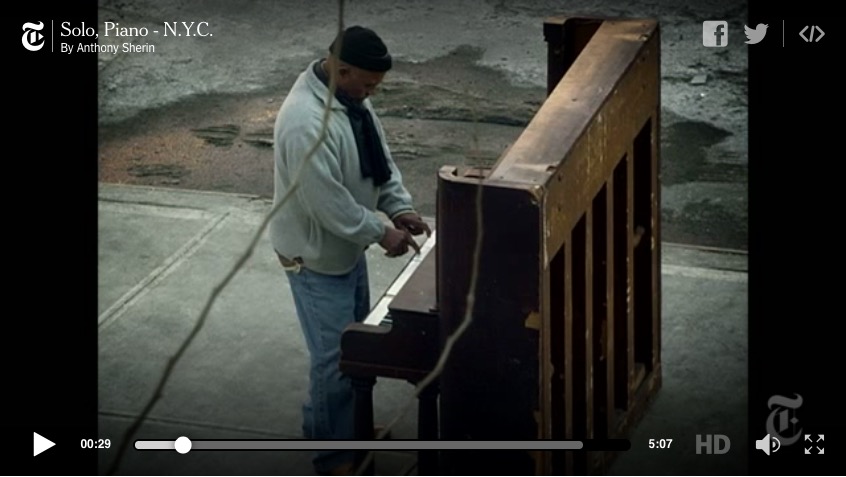
Anthony Sherin, “Solo, Piano — N.Y.C.,” New York Times, 12-11-12, screenshot
•
Should the sweetness of this meditation fail to assuage the gentle melancholy that year’s-end celebrations induce, then by all means dip into Will Braden’s YouTube series “Henri, the Existential Cat,” guaranteed to both echo and lift your wintertime blues — even if you don’t particularly care for cats.
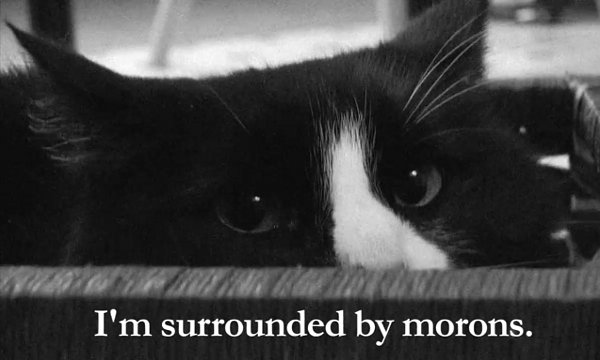
Will Braden, “Henri, the Existential Cat” (2007), screenshot
•
After that, see my winter 2014 piece on Walter Chandoha, “Father of the Cheezburger.” Follow up by reading “We Interview the ‘Godfather of Cat Photography’ Walter Chandoha” by Susan Michals, published at Artnet news on November 4, 2015. And top it off with “All Cats Must Go! ‘World’s Greatest Cat Painting’ Sells For $826,000,” by Cait Munro, November 3, 2015.
Of course, there’s always I Can Has Cheezburger.
Exit Through Gift Shop
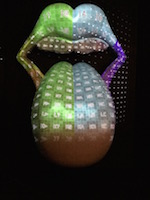
Rolling Stones, “Exhibitionism!” NYC, 2016. Installation photo © A. D. Coleman.
I had the opportunity to attend a press review of the touring Rolling Stones extravaganza, “Exhibitionism!” when it made its U.S. debut in New York City. Since this show emphasized the ways in which “the world’s greatest rock & roll band” used visual media — photography, film, video — to augment their music and market themselves, I reviewed it for Mac Edition Radio and Camera Chronicle.
Not all that much off-topic, methinks. An excerpt:
“The care that the Stones have taken from their beginning till now in crafting their individual and collective images becomes immediately evident … Toward that end, they worked with picture-makers as diverse as Cecil Beaton, David Bailey, Annie Leibovitz, Andy Warhol (who designed the notorious zipper cover for Sticky Fingers) and photographer-filmmaker Robert Frank, whose gritty feature-length film Cocksucker Blues they would end up censoring.”
But Is It Art?
My initial reaction to the headline of this late-November story, “Wife of Putin aide sparks outrage after Holocaust-themed ice dance,” was that this belonged in the What Were They Thinking Dept. But I decided to watch the video of this routine, “choreographed by 2002 Olympic silver medalist Ilya Averbukh, who is Jewish” for the Russian TV show “Ice Age,” before forming an opinion. I recommend that course of action to you.

Tatiana Navka and Andrei Burkovsky, “Ice Age,” 11-26-16, screenshot
I don’t hold that the Holocaust constitutes inappropriate subject matter for art. Indeed, given that a friend of Holocaust deniers and anti-Semites will occupy the White House in a matter of weeks, I favor just about anything that confirms that monstrosity as a real historical event and gets people thinking about it, even if it takes the form of entertainment.
So I approached this performance with as unbiased an outlook as I could muster — though I have to admit to a lack of interest in winter sports generally and a conviction that the “artistic” component of figure skating functions more as an aspiration than a proven fact.
Still, I did my best to keep an open mind. And, in that state, I judge the skaters’ routine a success. The narrative, drawn from the film Life is Beautiful, treats the subject respectfully. The skaters — Tatiana Navka, wife of Russian presidential spokesman Dmitry Peskov, and her partner Andrei Burkovsky — performed with grace, elegance, and nuanced expressions and gestures. Once I got over the visual shock of seeing two skaters wearing concentration-camp uniforms, I found the mini-drama engaging. For much of the routine’s eight minutes’ duration I forgot that they were skating; they became, as they prefer to style themselves, “ice dancers.”
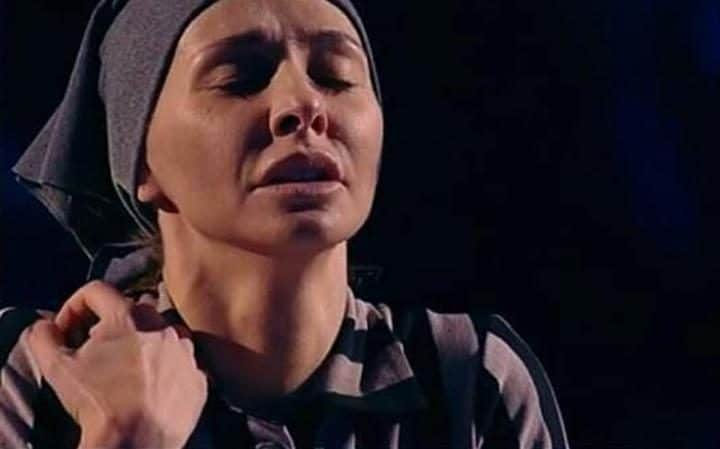
Tatiana Navka, “Ice Age,” 11-26-16, screenshot
Had Navka and Burkovsky (and choreographer Averbukh) been mimes, or modern dancers, I don’t think anyone, myself included, would have looked askance at this performance, much less questioned its legitimacy. Some prejudice against figure skating — some assumption of this activity’s inherent, insurmountable lack of gravitas, its classification as a sport and therefore at best a craft, never an art — seems to underlie the objections to this routine.
I think that’s unfortunate, even if I find most “artistic” figure skating lacking in anything that would qualify as creative. This performance did meet that standard, seeking to expand the boundaries of its medium by engaging with difficult, controversial subject matter. Navka, Burkovsky, and Averbukh took risks — not only the likelihood of automatically raising hackles in Russia (where anti-Semitism has always thrived) but the possibility of trivializing their routine’s subject matter and thus confirming what many consider the built-in expressive limits of their medium. To their credit, they did justice to the content and, by doing so, set a benchmark for their field.
Take a look and make your own assessment.
The Associated Press report concludes,
“… Holocaust-themed routines aren’t new to sports. In 1996, France’s synchronized swimming team had to scrap its program, which depicted the arrival of Jewish women in death camps and their final march to the gas chambers, following an intervention by the French sports minister. The routine was also based on a movie and set to music from Steven Spielberg’s “Schindler’s List.” (See this New York Times report for details.)
Makes me wish I could watch a video of that effort. At least it wasn’t Busby Berkeley and Esther Williams redux.
It’s Money that Matters
Is this good for photography?
 Back in 2013 we reached a milestone in the medium’s cultural history, one that certainly merited some celebration. Mea culpa: I took note of it at the time, but didn’t follow up quickly with a report. So, making belated amends, I direct your attention to this May 12, 2013 New York Times story by Patricia Cohen, “Valuable as Art, but Priceless as a Tool to Launder Money,” especially this section thereof:
Back in 2013 we reached a milestone in the medium’s cultural history, one that certainly merited some celebration. Mea culpa: I took note of it at the time, but didn’t follow up quickly with a report. So, making belated amends, I direct your attention to this May 12, 2013 New York Times story by Patricia Cohen, “Valuable as Art, but Priceless as a Tool to Launder Money,” especially this section thereof:
“Law enforcement officials complain that dealers are playing down arts role in a criminal underworld.
“In Newark, federal prosecutors in a civil case recently announced the seizure of nearly $16 million in fine art photographs as part of a fraud and money laundering scheme that prosecutors say was engineered by Philip Rivkin, a Texas businessman.
“The 2,200 photographs by masters like Alfred Stieglitz, Edward Weston and Edward Steichen — more than could fit into an 18-wheeler — were paid for, court papers say, with some of the $78 million that the authorities say Mr. Rivkin got from defrauding oil companies like Shell, Exxon, and Mobil. Mr. Rivkin, who has not been charged with any crimes, was last thought to be in Spain and had arranged to have the photos shipped there.”
And then this detailed follow-up from December 19, 2015 in The Art Newspaper, “Christie’s to sell 2,000 photographs seized by US government in biodiesel fraud,” by Helen Stoilas. Wrapping up with this report from Collector Daily, indicating that the total sales proceeds of the three-day auction reached $8,888,940 USD.
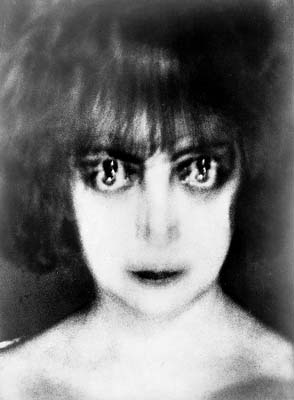
A forgery of Man Ray’s
“La Marquise Casati”
(1922)
Some celebrated cases of the initially successful forgery and sale of ostensibly vintage photographs in the late 20th century — prints purportedly by Man Ray, Lewis Hine, and others — honored the medium, albeit unintentionally. They did so by proving that forging photographs (at least images by recognized figures in the medium’s pantheon) had become a profitable enterprise, implicitly affirming that photographs had financial value.
By the same token, Philip Rivkin’s subsequent scam demonstrated that photographs — some of them, anyhow — have become valuable enough that, like works of visual art in the other media, they can now prove useful for money-laundering purposes, worth smuggling internationally.
 I find it surprising that such auction houses as Sotheby’s and Phillips de Pury, along with the Association of International Photography Art Dealers (AIPAD), from more than a few of whose members Rivkin acquired items in his collection, have not made more of this historic occasion. Certainly it represents a step forward for the medium of photography in its relation to the market and the economy — a proud moment, in my opinion, certainly meriting some formal acknowledgment as such.
I find it surprising that such auction houses as Sotheby’s and Phillips de Pury, along with the Association of International Photography Art Dealers (AIPAD), from more than a few of whose members Rivkin acquired items in his collection, have not made more of this historic occasion. Certainly it represents a step forward for the medium of photography in its relation to the market and the economy — a proud moment, in my opinion, certainly meriting some formal acknowledgment as such.
While I’m on the subject, here’s another measure of the medium’s ascendancy: Artnet News issues a monthly summary of the searches for artists’ names conducted within that site. The December 16 results show that of the top 12, 7 were photographers (8 if you count Andy Warhol):
- David Hamilton
- Jock Sturges
- Banksy
- Andy Warhol
- Nobuyoshi Araki
- Pablo Picasso
- Diane Arbus
- KAWS
- Robert Mapplethorpe
- Helmut Newton
- Keith Haring
- Nan Goldin
For whatever that’s worth. Of the top 300, by my rough count, I’d consider 57 of them photographers (in that they thought of themselves as such, or worked primarily or exclusively in this medium), with another dozen making photographs or “photo-based art” as at least part of their oeuvres.
Fact and Fancy
Now that we have a president-elect who believes and spreads fake news while denying the credibility and significance of real news, we have officially gone down a rabbit hole from which we’re unlikely ever to emerge.
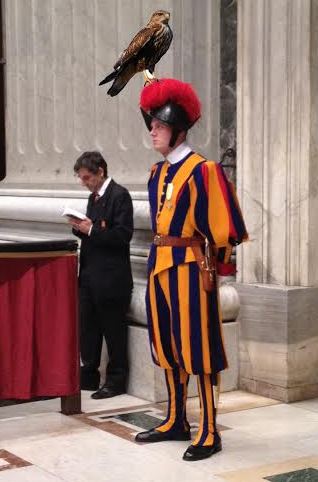
“Sylvia the hawk,” Independent Catholic News, 4-1-14
So you might want to bookmark the website iMediaEthics, which regularly debunks not just inaccurate reportage but outright fake news. As an example, I highly recommend “Is Sylvia the hawk Pope Francis’s latest weapon against evil? Latest Vatican Hoax,” from 2014. Alert: High ROFL potential.
I also recommend that you bookmark these two sites specializing in the production of fake news: The Onion, “America’s Finest News Source” (acquired a year ago by the Spanish-language broadcast channel Univision Communications Inc.) and The Daily Currant. You’re in for a deluge of unbelievable and/or fake news; might as well have ready access to sources that you know in advance provide nothing but.
And this blog’s readers shouldn’t miss “The Onion’s Best Photojournalism Of 2016.” In my opinion, “Noam Chomsky Announces Las Vegas Residency” can give anything at World Press Photo a run for its money.
I should confess my own small contributions to the growing trend toward fake news: An August 28, 2012 story on popular support for Russia’s Pussy Riot among mainland Chinese, and “‘Gremlyns of Light’: A Memoir,” an experiment in pseudoscience, published here on April 1, 2014.
•
This post supported in part by donations from John Bunty Turner, James Knowles, and Robert Schneider.
•
 Special offer: If you want me to either continue pursuing a particular subject or give you a break and (for one post) write on a topic — my choice — other than the current main story, make a donation of $50 via the PayPal widget below, indicating your preference in a note accompanying your donation. I’ll credit you as that new post’s sponsor, and link to a website of your choosing. Include a note with your snail-mail address (or email it to me separately) for a free signed copy of my 1995 book Critical Focus!
Special offer: If you want me to either continue pursuing a particular subject or give you a break and (for one post) write on a topic — my choice — other than the current main story, make a donation of $50 via the PayPal widget below, indicating your preference in a note accompanying your donation. I’ll credit you as that new post’s sponsor, and link to a website of your choosing. Include a note with your snail-mail address (or email it to me separately) for a free signed copy of my 1995 book Critical Focus!
 Donate now and I’ll include a copy of The Silent Strength of Liu Xia, the catalog of the 2012-13 touring exhibition of photos by the dissident Chinese photographer, artist, and poet, currently in her sixth year of extralegal house arrest in Beijing. The only publication of her photographic work, it includes all 26 images in the exhibition, plus another 14 from the same series, along with essays by Guy Sorman, Andrew Nathan, and Cui Weiping, professor at the Beijing Film Academy.
Donate now and I’ll include a copy of The Silent Strength of Liu Xia, the catalog of the 2012-13 touring exhibition of photos by the dissident Chinese photographer, artist, and poet, currently in her sixth year of extralegal house arrest in Beijing. The only publication of her photographic work, it includes all 26 images in the exhibition, plus another 14 from the same series, along with essays by Guy Sorman, Andrew Nathan, and Cui Weiping, professor at the Beijing Film Academy.
Ring In the New: 2017
… but don’t hold it while waiting for everything to turn out well.
Here we go again — yet another beginning of yet another year. Though one day’s much like the next, normally I find this symbolic fresh start buoying. This time around I can’t shake a lingering sense of dread.
Around these parts we hunker down and avoid all the trappings of the holidays, just poking our heads out when we know it’s over. If the season left you frazzled, and the impending presidential transfer of power has you anxious, take a moment to calm yourself down. Things are likely to get much, much worse very quickly, so you’ll need to have your wits about you.
•
You might start with “Solo, Piano — N.Y.C.,” a New York Times Op-Doc by Anthony Sherin published four years ago, on December 11, 2012. It’s a 5-minute film in stills about an old, abandoned upright piano meeting its fate on the sidewalks of new York after a January snowstorm, as seen from the window of Sherin’s Washington Heights apartment. Spoiler alert: Help, alas, does not arrive in the nick of time — so you can think of it as an elegiac metaphor for democracy as we have known it.
Anthony Sherin, “Solo, Piano — N.Y.C.,” New York Times, 12-11-12, screenshot
•
Should the sweetness of this meditation fail to assuage the gentle melancholy that year’s-end celebrations induce, then by all means dip into Will Braden’s YouTube series “Henri, the Existential Cat,” guaranteed to both echo and lift your wintertime blues — even if you don’t particularly care for cats.
Will Braden, “Henri, the Existential Cat” (2007), screenshot
•
After that, see my winter 2014 piece on Walter Chandoha, “Father of the Cheezburger.” Follow up by reading “We Interview the ‘Godfather of Cat Photography’ Walter Chandoha” by Susan Michals, published at Artnet news on November 4, 2015. And top it off with “All Cats Must Go! ‘World’s Greatest Cat Painting’ Sells For $826,000,” by Cait Munro, November 3, 2015.
Of course, there’s always I Can Has Cheezburger.
Exit Through Gift Shop
Rolling Stones, “Exhibitionism!” NYC, 2016. Installation photo © A. D. Coleman.
I had the opportunity to attend a press review of the touring Rolling Stones extravaganza, “Exhibitionism!” when it made its U.S. debut in New York City. Since this show emphasized the ways in which “the world’s greatest rock & roll band” used visual media — photography, film, video — to augment their music and market themselves, I reviewed it for Mac Edition Radio and Camera Chronicle.
Not all that much off-topic, methinks. An excerpt:
“The care that the Stones have taken from their beginning till now in crafting their individual and collective images becomes immediately evident … Toward that end, they worked with picture-makers as diverse as Cecil Beaton, David Bailey, Annie Leibovitz, Andy Warhol (who designed the notorious zipper cover for Sticky Fingers) and photographer-filmmaker Robert Frank, whose gritty feature-length film Cocksucker Blues they would end up censoring.”
But Is It Art?
My initial reaction to the headline of this late-November story, “Wife of Putin aide sparks outrage after Holocaust-themed ice dance,” was that this belonged in the What Were They Thinking Dept. But I decided to watch the video of this routine, “choreographed by 2002 Olympic silver medalist Ilya Averbukh, who is Jewish” for the Russian TV show “Ice Age,” before forming an opinion. I recommend that course of action to you.
Tatiana Navka and Andrei Burkovsky, “Ice Age,” 11-26-16, screenshot
I don’t hold that the Holocaust constitutes inappropriate subject matter for art. Indeed, given that a friend of Holocaust deniers and anti-Semites will occupy the White House in a matter of weeks, I favor just about anything that confirms that monstrosity as a real historical event and gets people thinking about it, even if it takes the form of entertainment.
So I approached this performance with as unbiased an outlook as I could muster — though I have to admit to a lack of interest in winter sports generally and a conviction that the “artistic” component of figure skating functions more as an aspiration than a proven fact.
Still, I did my best to keep an open mind. And, in that state, I judge the skaters’ routine a success. The narrative, drawn from the film Life is Beautiful, treats the subject respectfully. The skaters — Tatiana Navka, wife of Russian presidential spokesman Dmitry Peskov, and her partner Andrei Burkovsky — performed with grace, elegance, and nuanced expressions and gestures. Once I got over the visual shock of seeing two skaters wearing concentration-camp uniforms, I found the mini-drama engaging. For much of the routine’s eight minutes’ duration I forgot that they were skating; they became, as they prefer to style themselves, “ice dancers.”
Tatiana Navka, “Ice Age,” 11-26-16, screenshot
Had Navka and Burkovsky (and choreographer Averbukh) been mimes, or modern dancers, I don’t think anyone, myself included, would have looked askance at this performance, much less questioned its legitimacy. Some prejudice against figure skating — some assumption of this activity’s inherent, insurmountable lack of gravitas, its classification as a sport and therefore at best a craft, never an art — seems to underlie the objections to this routine.
I think that’s unfortunate, even if I find most “artistic” figure skating lacking in anything that would qualify as creative. This performance did meet that standard, seeking to expand the boundaries of its medium by engaging with difficult, controversial subject matter. Navka, Burkovsky, and Averbukh took risks — not only the likelihood of automatically raising hackles in Russia (where anti-Semitism has always thrived) but the possibility of trivializing their routine’s subject matter and thus confirming what many consider the built-in expressive limits of their medium. To their credit, they did justice to the content and, by doing so, set a benchmark for their field.
Take a look and make your own assessment.
The Associated Press report concludes,
“… Holocaust-themed routines aren’t new to sports. In 1996, France’s synchronized swimming team had to scrap its program, which depicted the arrival of Jewish women in death camps and their final march to the gas chambers, following an intervention by the French sports minister. The routine was also based on a movie and set to music from Steven Spielberg’s “Schindler’s List.” (See this New York Times report for details.)
Makes me wish I could watch a video of that effort. At least it wasn’t Busby Berkeley and Esther Williams redux.
It’s Money that Matters
Is this good for photography?
“Law enforcement officials complain that dealers are playing down arts role in a criminal underworld.
“In Newark, federal prosecutors in a civil case recently announced the seizure of nearly $16 million in fine art photographs as part of a fraud and money laundering scheme that prosecutors say was engineered by Philip Rivkin, a Texas businessman.
“The 2,200 photographs by masters like Alfred Stieglitz, Edward Weston and Edward Steichen — more than could fit into an 18-wheeler — were paid for, court papers say, with some of the $78 million that the authorities say Mr. Rivkin got from defrauding oil companies like Shell, Exxon, and Mobil. Mr. Rivkin, who has not been charged with any crimes, was last thought to be in Spain and had arranged to have the photos shipped there.”
And then this detailed follow-up from December 19, 2015 in The Art Newspaper, “Christie’s to sell 2,000 photographs seized by US government in biodiesel fraud,” by Helen Stoilas. Wrapping up with this report from Collector Daily, indicating that the total sales proceeds of the three-day auction reached $8,888,940 USD.
A forgery of Man Ray’s
“La Marquise Casati”
(1922)
Some celebrated cases of the initially successful forgery and sale of ostensibly vintage photographs in the late 20th century — prints purportedly by Man Ray, Lewis Hine, and others — honored the medium, albeit unintentionally. They did so by proving that forging photographs (at least images by recognized figures in the medium’s pantheon) had become a profitable enterprise, implicitly affirming that photographs had financial value.
By the same token, Philip Rivkin’s subsequent scam demonstrated that photographs — some of them, anyhow — have become valuable enough that, like works of visual art in the other media, they can now prove useful for money-laundering purposes, worth smuggling internationally.
While I’m on the subject, here’s another measure of the medium’s ascendancy: Artnet News issues a monthly summary of the searches for artists’ names conducted within that site. The December 16 results show that of the top 12, 7 were photographers (8 if you count Andy Warhol):
For whatever that’s worth. Of the top 300, by my rough count, I’d consider 57 of them photographers (in that they thought of themselves as such, or worked primarily or exclusively in this medium), with another dozen making photographs or “photo-based art” as at least part of their oeuvres.
Fact and Fancy
Now that we have a president-elect who believes and spreads fake news while denying the credibility and significance of real news, we have officially gone down a rabbit hole from which we’re unlikely ever to emerge.
“Sylvia the hawk,” Independent Catholic News, 4-1-14
So you might want to bookmark the website iMediaEthics, which regularly debunks not just inaccurate reportage but outright fake news. As an example, I highly recommend “Is Sylvia the hawk Pope Francis’s latest weapon against evil? Latest Vatican Hoax,” from 2014. Alert: High ROFL potential.
I also recommend that you bookmark these two sites specializing in the production of fake news: The Onion, “America’s Finest News Source” (acquired a year ago by the Spanish-language broadcast channel Univision Communications Inc.) and The Daily Currant. You’re in for a deluge of unbelievable and/or fake news; might as well have ready access to sources that you know in advance provide nothing but.
And this blog’s readers shouldn’t miss “The Onion’s Best Photojournalism Of 2016.” In my opinion, “Noam Chomsky Announces Las Vegas Residency” can give anything at World Press Photo a run for its money.
I should confess my own small contributions to the growing trend toward fake news: An August 28, 2012 story on popular support for Russia’s Pussy Riot among mainland Chinese, and “‘Gremlyns of Light’: A Memoir,” an experiment in pseudoscience, published here on April 1, 2014.
•
This post supported in part by donations from John Bunty Turner, James Knowles, and Robert Schneider.
•